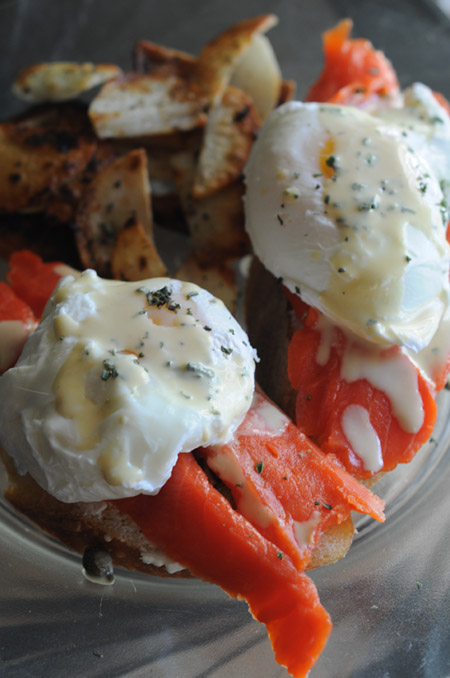On the weekends I love making real breakfast. I mean, not that quick cereal, instant oatmeal, boiled eggs, whatever grub you grab the other 5 days out of the week. And I love making eggs for breakfast!
So here is a quick overview of Smoked Salmon Eggs Benedict that will undoubtedly turn out as good or better than your local diner (or a classy yuppie joint) gets you for brunch on a Sunday morning.

Smoked Salmon Eggs Benedict
Method: Poaching
Cookware: Heavy Sauté pan (or French skillet)
Ingredients:
Eggs (2 per 1 person serving)
English muffins or any soft white bread
Your favorite fresh herbs (optional) — marjoram, dill, fennel, tarragon
Smoked Salmon
Capers
Cream Cheese
Hollandaise or a quick *Substitute sauce
Cookin‘: (the eggs)
- Bring water (just enough to cover the eggs) to a boil in your Sauté pan, turn heat down to a slight simmer and add few tablespoons of vinegar and a pinch of salt to water while its boiling. Meanwhile,
- Break the muffin into two pieces or slice the bread. Today I used fresh, soft sourdough baguette sliced slightly diagonally to give it larger pieces.
- Spread a light amount of cream cheese on both slices
- Put a ½ tea-spoon of capers on each slice and then smoked salmon on top
- Break each egg into an individual small bowl (2 bowls for 2 eggs, you are not making an omelet here)
- Gently lower the eggs, one by one in lightly simmering water. Simmer eggs until the whites are firm and the yolks are still runny (test that with silicon or wooden spatula). Depending on type of cookware you use this should take anywhere between 5 to 8 minutes. Do Not Boil Eggs! Simmer, and simmer gently.
- Lift up eggs with a slotted spoon and pat dry on the sides with a paper towel. Put on top of Salmon. Sprinkle some of your herbs on the top.
- Cover with Hollandaise or the quick *Substitute (see below).
Serve with home-fried potatoes or any other favorite breakfast carbs.
Hollandaise Sauce:
You’re gonna fuck it up the first time you make it, as it sort of takes time to develop a “touch” for making this sauce. So you might want to start with a substitute, which I actually use when I make this just for myself (Saves on calories, that’s for sure). If I cook for friends or more than a few people, I will certainly make a Hollandaise.
2 egg yolks
½ stick of butter (you can experiment with adding less butter, if so add a tbsp of heavy cream)
2 table spoons vinegar (or white wine, or lemon juice – experiment)
salt and pepper
1. Melt butter in a small heavy saucepan on low heat.
2. Whisk yolks with vinegar and season with salt and pepper.
3. Take the saucepan off heat and whisk in the yolk mixture, keep whisking.
4. Optional: You can add a tablespoon of heavy cream to this mixture, especially if you overcook your sauce. (Which is likely to happen on the first few attempts)
If the sauce is too thin, put the saucepan back to lowest heat for a second or two, while whisking. Care not to apply too much heat this will ruin the sauce.
* Substitute Sauce:
Take a tsp. of mayo and 1 ½ tsp. of Dijon mustard. Mix together in a small dish while adding some cider vinegar. Add vinegar slowly to avoid clumps. Reach desired consistency. It should coat the spoon, ideally. A few dashes of hot sauce can never hurt as another add-on.
Tips & Tricks:
For the eggs: Always add vinegar to water while poaching eggs. Gently add eggs to a medium simmer. Care not to boil the eggs. Use a wide, shallow pan – a sauté pan is ideal.
For the Hollandaise: Experiment with the amount of butter. Original recipe calls for a fair amount of it, but I notice that you can create a very nice, not too rich sauce by adding much less butter and a few tablespoons of heavy cream. DO NOT even think of leaving this sauce on too much heat, never get above lowest heat setting on your stove. Many recipes for Hollandaise recommend whisking in melted butter into a bowl of whisked yolks, thus avoiding heat at all. This works quite well, is easier to control, but requires more butter and doesn’t allow as much flexibility adjusting the sauce.